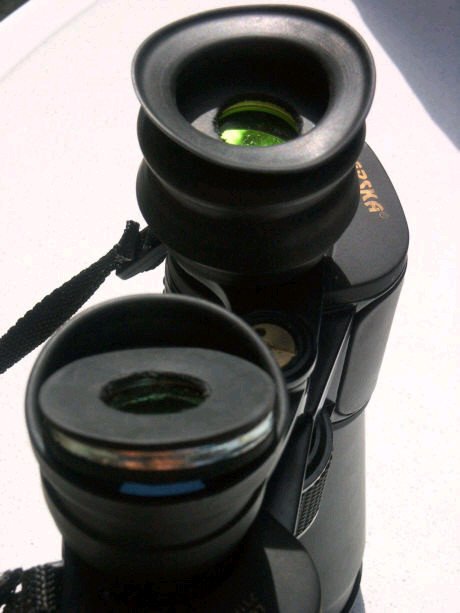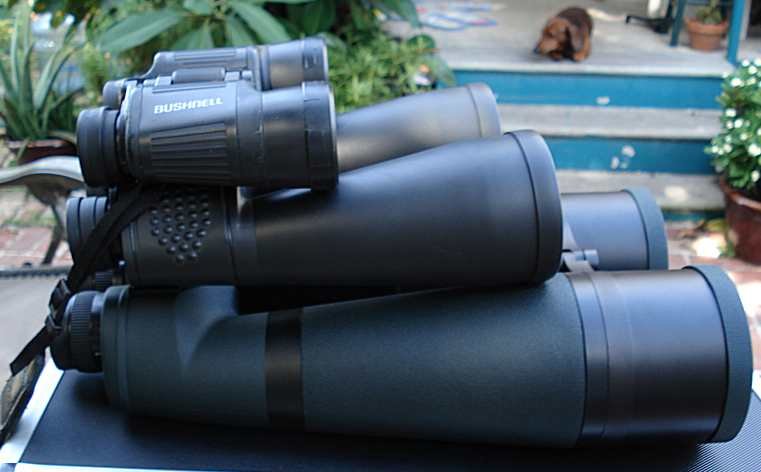
Photo : Giant binocular with light pollution filter fitted inside the eyepiece cup.
Note : an earlier version of my article was published on the Cloudy Nights astronomy site.
I bought a 1.25" Celestron UHC/LPR filter to help combat the local light pollution. Such filters are made to be used with telescopes, but I tried using one in combination with my 100mm binoculars. Here are the results of my mad experiment.
I got a great deal on a used Celestron "UHC/LPR" filter. Honestly, I am not sure whether this filter qualifies as a narrowband or broadband. I had previously heard that "Ultra High Contrast UHC" was used in conjunction with narrowband filters. While SkyGlow, Deep Sky, and many other light pollution filters were called broadband because they only blocked the mercury and sodium bands. At any rate, this filter is labeled as both, and after the reading the official plug on the Celestron site, I am still unsure.
I have the 1.25" filter now and the skies were clear last night - very clear but with average seeing. I set up the 25x100 Skymaster binos and the 60mm refractor and decided to give the filter a test. I will skip over most of the scope portions of the testing, suffice to say that the filter works as expected, although the results are subtle in the What I have been itching to try for some time now, and it's the whole reason I bought the filter, is to use the filter in conjunction with the big binoculars. In short, the first attempts were promising. In practice, some method of firmly holding the filter to the ep of the bino will be required to make full use of the benefits. The filter is a tad to small to sit of it's own accord within the confines of the rubber ep cup. If the binoculars are tilted backwards towards the zenith, the filter will fall out of the cup. So one must carefully hold the filter (without getting fingerprints on it) up against the ep lens of the bino. The first big test was on M42 and the surrounding environs of the Orion Complex. This area is rich with nebulosity, so it was the logical place to start.
At the time of the first test, Orion was just rising over my neighbor's house. That low portion of the sky is heavily-light polluted, and the sky is a light aquamarine color up to about 35 degrees from the horizon. This is where Orion was when I turned the 100mm binos on him and held the filter against the ep.
The image in the filtered ep appeared to "condense" down a bit and get smaller (barely noticeable), and the color tint of the view took on a slight bluish tone. But there was more nebulosity visible on the filtered ep as opposed to the unfiltered. The difference was subtle, but enough to be readily apparent. With both ep-cups rolled back, and the filter pressed gently but firmly up against the ep rim (and rolled back "lip" of the ep cup), my brain could merge the two images. At first it was difficult, because the left ep (my dominate eye and the filtered side) appeared a tad smaller and more blue. This played havoc with my ability to merge the image. It was almost like looking through a bino horribly out of collimation. But with some effort and using a trick akin to averted vision, I was able to merge the images into a useable view. I would guesstimate that 20-25% more nebulosity was visible when viewing both sides and using averted vision. When the filter was held over one ep and the opposing eye was closed (thus turning the bino into a single 4" refractor) the benefit was reduced while viewing a single barrel with direct vision. I'd say a ~10% increase in visible nebulosity. The full benefit was only attained when viewing with both eyes open, the filter over my left ep, and using averted vision.
I used to method to confirm some nebulosity that I had only previously suspected. I glimpsed subtle traces of nebulosity, using "combined averted merging" in the region of NGC's 1973, 1975, and 1977. Without the use of the filter, nebulosity was only suspected in this areas with averted vision. It's definitely there and movable when tapping the barrels, when viewed with the filter.
I went back to area around Alnitak and confirmed a tiny amount of nebulosity that I had only previously suspected before. Although, even with filter, the appearance of the nebulosity was very small and faint - limited to the immediate area around the bright star. I was not as confident confirming this as I was NGCs 1973/75/77. In this case, I could have been seeing diffuse glare from the intense shine of Alnitak. Whatever it was, I saw something that I had only vaguely suspected without the UHC/LPR.
Quickly....I also looked for M1, scanning with the filter and telescope at 27x and 70x using my new GSO 10mm Superview ep (wide field). Nothing. Apparently the filter was of no use when looking for this supernova remnant - perhaps not the right composition to benefit much from this filter? Or my skies are just not dark enough, filter or not.
The Moon, once it came up, looked electric blue-purple through the filter. Nice coloring. Neat to look at, but useless.
That part of the skyglow that looks bright aquamarine to the east, looked black under the filter, both through the binos and scope. The filter does visually block all noticeable skyglow, while darkening the view at the same time.
If I can find a method to securely attach the filter to the bino ep, then this combination may prove useful in the future. But holding the filter against the ep made the view suffer from shakes - from the continued contact between my hand and the bino body. No matter how motionless I tried to be, the presence of my hand and filter induced slight shaking into the view - reducing it's usefulness. This will have to be remedied.

Photo : small, large, and giant binoculars.
PART TWO :
The night before last, I went out for ~6 hours and did some more rigorous testing on the filter/binocular combo.
The results were encouraging, again.
Given my washed-out skies, and the time of year, there are not many nebulous objects visible in my backyard patch of sky. But, the Orion Complex was clearly visible and unobstructed all night, so I concentrated my efforts there...again.
I did find a better method of holding the filter to the bino ep. It was simple - don't touch the bino with hand or filter. I simply held the filter between thumb and forefinger and placed it between my eye and the eyepiece lens. After some fiddling around with distance and angle, I found the best orientation for holding the filter. My hand and filter may sway a little, but the view through the stationary bino eps remains constant. For all intents and purposes, this solved the shakiness problem.
Now for the "tests" and results.
Over a period of several hours, as M42 rose higher and higher into the sky, I observed it using the filter and without using the filter.
My local skies are light polluted. The south-eastern sky where Orion makes his nightly trek, becomes increasingly washed out and bright as one approaches the horizon line. In effect, the sky is a bright aquamarine color up until approx. the 30-35° mark upwards towards the zenith. Between 35-45° the sky transitions from a light bluish to a darker blue. At ~50° and up to the zenith, the sky becomes a solid and uniform dark navy tone. So, as one would assume, M42 increases in contrast and visibility as it rises from the horizon. When Orion first appears above my neighbor's roof, the nebula is all but invisible to direct vision with anything less than the 25x100 bino. Even with two 100mm lenses, the appearance of M42 at Consistently, throughout the night, M42 attained greater levels of visibility and contrast with the application of the filter. The biggest increase came when using both eyes open and with averted vision. Was the increase shocking and mind-blowing? No. The improvement was subtle, but definitely noticeable. I estimate that the appearance of M42 while filtered at a height of The price to be paid for this improved view is the inconvienence of holding the filter between eye and ep. In addition, merging the images of filtered-view and unfiltered-view takes some practice and concentration to achieve a single hybrid image that is a product of both.
Holding one eye closed and looking through the filtered eye only still gave an improved view in terms of increased volume of nebulosity visible. But, the image scale appeared to shrink somewhat and the entire view took on a bluish cast from the filter. This reduced and tinted view is partially-negated by opening the other unfiltered eye and then merging the two images. Doing this under direct vision yields benefits, but applying averted vision to this merged hybrid is what really brings positive results. When done thusly, the improvement is marked.
I tried locating M1 again - both with the filtered bino and telescope. No luck again. Apparently the filter is of no benefit when looking for this supernova remnant.
Holding the filter up with the naked eye and scanning the area around Deneb in Cygnus, yielded no trace of NGC 7000 or any other noticeable nebulosity. Of course, by this time of year, Cygnus is sinking into the west - which is more horribly light polluted than my eastern views. So I was not surprised when the filter failed to pick out the elusive NA nebula.
In conclusion, I would recommend picking up a cheap/used filter for use with the binocular, IF, your local skies are very light polluted and you don't get out to dark skies very often. I would not recommend going out and buying a brand new Lumicon or other high-dollar filter exclusively for use with a giant bino in this fashion. The improvement simply doesn't justify spending $100 on a filter. But if a filter can be had cheap, or if you already own a scope and filter, then I would suggest keeping a UHC/LPR filter in your goodie bag for use with binoculars. In my opinion, this filter makes a nice compliment to the binocular.
I would welcome, and strongly encourage, other more experienced observers to duplicate or deny this experiment. I would be interested to hear the results and input of someone who can better quantify the effects.
Until next time, clear dark skies and keep looking up!
MikeG
Photo credits : All photos by me or used with permission (Michael Gilmer, Galactic Stone)
All of my astronomy, meteorite, and science articles - https://steemit.com/@galacticstone
Hi! I am a robot. I just upvoted you! I found similar content that readers might be interested in:
https://www.cloudynights.com/topic/46825-preliminary-test-of-uhclpr-filter-and-binocular/
Yes, that is where I originally posted the article. I am the author.
The people from @steemcleaners have a "Cheetah Support" thread in their Discord Group. You might be able to find out how to avoid those comments on our own work.
As long as the bot upvotes me every time, and I am not being punished in some way, then I am OK with it. I've never used Discord.